 Website:
Şişecam
Website:
Şişecam
Catalog excerpts
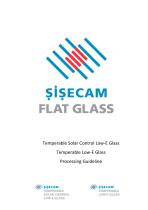
Temperable Solar Control Low-E Glass Temperable Low-E Glass Processing Guideline
Open the catalog to page 1
STORAGE CONDITIONS DETERMINING THE COATED SIDE OF THE GLASS EDGE DELETION EDGE PROCESSING SCREEN PRINTING THERMAL TOUGHENI
Open the catalog to page 2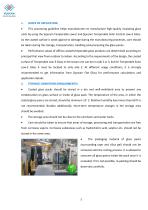
This processing guideline helps manufacturers to manufacture high-quality insulating glass units by using the Şişecam Temperable Low-E and Şişecam Temperable Solar Control Low-E Glass. As the coated surface is weak against to damage during the manufacturing processes, care should be taken during the storage, transportation, handling and processing the glass panes. • Performance values of offline coated temperable glass products are determined according to principal that view from outdoor to indoor. According to the requirements of the design, the coated surface of Temperable Low-E Glass in...
Open the catalog to page 3
Coated glass packs should not be unsealed until the temperatures of the packs get roughly equal to the indoor temperature. Unsealing packs before achieving the indoor temperature may cause condensation of humidity between the panes with corrosive effects on the coating. • If any condensation occurs on the outer surface of the front and back panes of the pack, it should be dried in order to avoid the entrance of water into the pack when it is unsealed. • After unsealing the surrounding tape of the glass, silica gel must be removed completely. Any silica gel particles remaining between the...
Open the catalog to page 4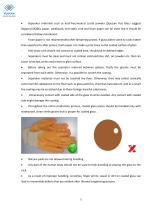
Separator materials such as acid-free/neutral Lucite powder (Şişecam Flat Glass suggest Degacryl M286), paper, cardboard, anti-static cork and foam paper can be used. But it should be considered below mentioned: - Foam paper is not recommended after tempering proses. If glass plates come to racks hotter than expected to after proses, foam paper can make a print trace to the coated surface of glass. - Anti-static cork should not contact to coated area, should put to deleted edges. Separators must be clean and must not contain solid particles, dirt, oil, powder etc. that can cause scratches,...
Open the catalog to page 5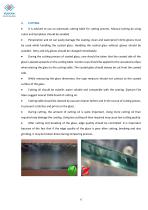
It is advised to use an automatic cutting table for cutting process. Manual cutting by using rulers and templates should be avoided. • Perspiration and oil can easily damage the coating, clean and waterproof nitrile gloves must be used while handling the coated glass. Handling the coated glass without gloves should be avoided. Dirty and oily gloves should be changed immediately. • During the cutting process of coated glass, care should be taken that the coated side of the glass is placed upwards on the cutting table. Suction cups should be applied to the uncoated surface when placing the...
Open the catalog to page 6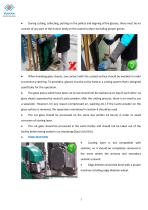
During cutting, collecting, putting on the pallets and aligning of the glasses, there must be no contact of any part of the human body on the coated surface excluding proper gloves. When breaking glass sheets, any contact with the coated surface should be avoided in order to prevent scratching. To provide it, glasses must be cut by hand or a cutting system that is designed specifically for this operation. • The glass panes which have been cut to size should not be stacked up on top of each other. As glass sheets separated by neutral Lucite powder, after the cutting process, there is no need...
Open the catalog to page 7
Brush milling, felt milling and hand type edge deletion systems are not suitable. In order to identify the edge deletion quality, coating detectors should be used. The width of the deleted area must be minimum 10 mm if polyurethane or polysulfide is used as a secondary sealant (if argon gas is used inside the IGU cavity, it must be minimum 11 mm) and minimum 13 mm if silicone is used as an outer sealant (if argon gas is used inside the IGU cavity, it must be minimum 15 mm). • After edge deletion, ensure that the deleted part is totally cleaned out of from the glass surface. If edge deletion...
Open the catalog to page 8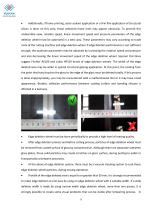
Additionally, if frame printing, outer sealant application or a thin film application of structural silicon is done on this area, those yellowish linear lines may appear obviously. To prevent this undesirable view, rotation speed, linear movement speed and pressure parameters of the edge deletion wheel must be optimized in a best way. These parameters may vary according to trade mark of the cutting machine and edge deletion wheel. If edge deletion performance is not sufficient enough, the optimum parameters may be obtained by increasing the rotation speed and pressure and also decreasing...
Open the catalog to page 9
other words, to make edge deletion larger than 20 mm, an edge deletion table should be used apart from the edge deletion system that is assembled inside the cutting machine. • It is important to use an adjustable deletion system (width, speed, pressure), to meet different requirements of erasing process. • At some projects, larger edge deleted areas (50 mm or wider) may be required especially at corner parts of the buildings. In similar cases, tempering problems like breakage, undulation etc. may be encountered. The reason of these problems are due to the fact that the edge deleted area of...
Open the catalog to page 10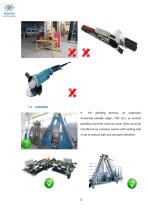
horizontal (double edger, CNC etc.) or vertical grinding machines must be used. Glass must be transferred on conveyor system with coating side is not in contact with any conveyor elements.
Open the catalog to page 11
For the horizontal edge grinding machines (double edger), top clamping belt must be smooth and non-textured in order not to damage the coated surface. Additionally, there must be a pulverize water nozzle and brush system to keep the upper belt wet and clean that located at entrance section. For other types of edging machines (CNC), care must be taken to avoid the contact of any transferring or processing elements with coating surface. During edge grinding, glass panes should not let dry and have to be washed immediately after processing. • Double edger lines should work in both directions...
Open the catalog to page 12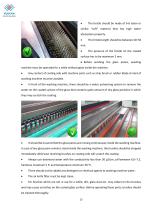
The bristle should be made of 6-6 nylon or similar “soft” material that has high water absorption property. • The bristle length should be between 40–50 The pressure of the bristle on the coated surface has to be maximum 2 mm. • Before washing the glass panes, washing machine must be operated for a while without glass inside the machine. • Any contact of coating side with machine parts such as strip brush or rubber blade at inlet of washing machine must be avoided. • In front of the washing machine, there should be a water pulverizing system to remove the water on the coated surface of the...
Open the catalog to page 13All Şişecam catalogs and technical brochures
-
Solar Glass
2 Pages
-
Reflective Thermal Risk
2 Pages
-
Lacquered Glass
5 Pages
-
Coated Glass
13 Pages
-
Şişecam Tentesol Titanium
13 Pages
-
Şişecam Tentesol
13 Pages
-
Şişecam Temperable Low-E Glass
13 Pages
-
Reference Projects 2021
107 Pages
-
FLOTAL
2 Pages
-
Şişecam Low-E Glass
24 Pages
-
Şişecam Wired Glass
2 Pages
-
Şişecam Tinted Float Glass
4 Pages
-
Şişecam Picture Frame Glass
2 Pages
-
Şişecam Patterned Glass
2 Pages
-
Şişecam Laminated Glass
2 Pages
-
Şişecam Lacquered Glass
2 Pages

























